The Easy Way to be a Television Producer
I installed a review copy of Adobe Premiere Elements in September and have been trying to find time since then to take it out for a test drive. Instead, the introduction turned out to be a trial by fire in the week after a niece and nephew were baptized. I took along a Canon point-and-shoot camera that could record video. With more than an hour's worth of raw video, I was faced with finding a way to edit it to a more manageable length while still retaining the flavor of the event.
The resulting video (you can see it on Vimeo) is a bit less than 11 minutes long. It's clear that I am not a great videographer but it's also clear that an application such as Premiere Elements will allow even mediocre video to be edited so that it won't put people to sleep.
My usual preference is to use simple cut transitions but I didn't do any work on the audio track and simple cuts were too abrupt. Instead, I elected to use cross-fades ranging from 1 to 5 seconds.
Premiere Elements is not the application your local television station will choose and but it's exactly what most amateur videographers will want and here's why: The application has two modes, Quick and Expert. Start with the Quick mode because it's the one that allows you to create edits, insert titles, and apply transitions with ease. This is essentially the equivalent of using your camera in automatic mode. As you learn more about your camera, you may yearn for more control and you'll find the many manual adjustments that are available. The same is true with Premiere Elements: The Quick mode is astonishingly robust but eventually you'll want more. You'll want to have more control of the audio track. You'll want more precise editing control for the video. That's when you'll click the Expert button and find a new range of capabilities.
Adobe's consumer-product managers state uniformly that their goal is to provide applications that people will be able to use as soon as they install them and Premiere Elements is an outstanding example of that philosophy. Who would have thought, even as recently as a decade ago, that people who have had no training in video production techniques would be empowered to edit video on their home computers! And Adobe's product managers also talk about a second goal of providing applications that will allow users to grow as their understanding grows. Take the first steps with Quick mode but then expand your horizons with the Expert mode. Here, again, Adobe gets it right.
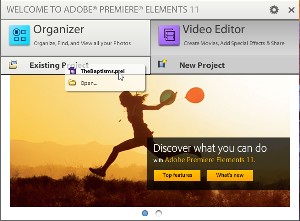 When you start Premiere Elements 11 (or Photoshop Elements 11), you'll have the option of starting with the Organizer, which is where you should prepare all of the media clips that you plan to use, or in the Editor. Here, I've selected the Editor, which offered the option of creating a new project or opening an existing project.
When you start Premiere Elements 11 (or Photoshop Elements 11), you'll have the option of starting with the Organizer, which is where you should prepare all of the media clips that you plan to use, or in the Editor. Here, I've selected the Editor, which offered the option of creating a new project or opening an existing project.
To make everything even easier, you can follow links to some video training programs.
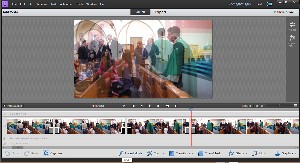 This is easy. Each video clip is shown in the order that I used to place it and each clip automatically connects to the next. This is helpful when you insert or delete clips because there's no need to manually move everything around. The icons at the bottom of the screen provide ways to drop effects, transitions, music, and more into the project.
This is easy. Each video clip is shown in the order that I used to place it and each clip automatically connects to the next. This is helpful when you insert or delete clips because there's no need to manually move everything around. The icons at the bottom of the screen provide ways to drop effects, transitions, music, and more into the project.
The timeline indicator (think of it as a play head) is indicated by the thin red vertical line, which is between scenes where I've used a crossfade transition.
After editing the video from a few events this way, you might begin wishing that you had more control—and you do. Just switch to the Expert view.
With this view activated, you can add a new video track (professionals know this as "B-roll") or a new audio track. Or several of each. The various tracks can be cross-faded and mixed together, so if you were thinking that there were no powerful features here this will convince you otherwise.
The video's audio track is imported, of course, but by default you'll also have a narration track (for voice-overs) and a soundtrack track (for music and sound effects). For a program that's both inexpensive and easy to use, this is a remarkably robust series of features.
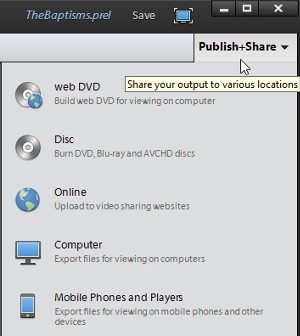 Before looking at the rest of the production process, take a look at how easy Adobe makes it to prepare your video for others. This has been the downfall of many video editing programs. The editing process can be made relatively simple but once you've completed your video, there's an astonishing array of options to choose from when you want to create something that you can share.
Before looking at the rest of the production process, take a look at how easy Adobe makes it to prepare your video for others. This has been the downfall of many video editing programs. The editing process can be made relatively simple but once you've completed your video, there's an astonishing array of options to choose from when you want to create something that you can share.
Premiere Elements offers 5 major options that cover the primary ways that amateurs will want to share video. Select one and you'll be offered equally easy choices that will guide you to creating a DVD, a Blu-ray disc, an online video, video for a phone, or simply a file that you can view on the computer.
Putting it All Together
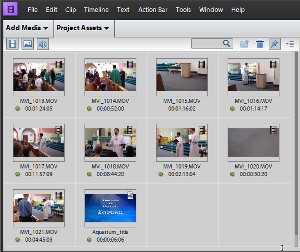 After downloading video from your camera, camcorder, or webcam, you'll have an array of project assets. Select these and drop them onto the timeline. Once you've done that, the fun really begins.
After downloading video from your camera, camcorder, or webcam, you'll have an array of project assets. Select these and drop them onto the timeline. Once you've done that, the fun really begins.
Fun, in this case, lives under the icons on the lower right side of the window:
- Instant Movie: Let Premiere Elements to the work.
- Tools: Adjust the color and gamma of the video; mix the audio tracks; create a freeze frame; or add a menu, narration, or a pan/zoom effect.
- Transitions: Select from dozens of transition effects, drop them between clips, and modify the speed with which they animate.
- Titles & Text: Add opening credits, closing credits, or superimpose text on a scene.
- Effects: Modify the image to create a film effect or try to stabilize a shaky image.
- Music: Add some mood music to your presentation and, if you really want to become creative, download and install the light version of SmartSound.
- Graphics: Drop an animated object or icons on top of images.
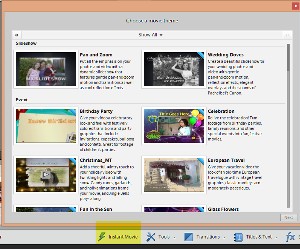 Instant Movie: Premiere Elements offers a variety of themes such as Pan and Zoom, Wedding Doves, Celebration, and Birthday Party. Select one and choose Next. You'll be asked a few questions and given a few options; then Premiere Elements will create a program for you.
Instant Movie: Premiere Elements offers a variety of themes such as Pan and Zoom, Wedding Doves, Celebration, and Birthday Party. Select one and choose Next. You'll be asked a few questions and given a few options; then Premiere Elements will create a program for you.
It may not be exactly what you want, but it might be a perfect starting point.
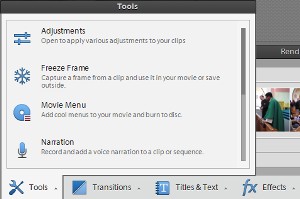 Tools: Here you can modify the exposure and color of each scene or perform one of several other tasks that convert your video from a disjointed series of images into something that makes sense. And it's under this menu that some of the most powerful features live. Time Remaping and Time Stretch allow you to speed a scene or make it slower.
Tools: Here you can modify the exposure and color of each scene or perform one of several other tasks that convert your video from a disjointed series of images into something that makes sense. And it's under this menu that some of the most powerful features live. Time Remaping and Time Stretch allow you to speed a scene or make it slower.
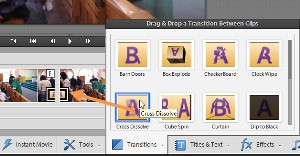 Transitions: Adobe has gone overboard here. You'll find 16 various classifications or groups of transition effects and under each of those group headings, a series of related effects.
Transitions: Adobe has gone overboard here. You'll find 16 various classifications or groups of transition effects and under each of those group headings, a series of related effects.
It is my duty to point out here that professional film makers and videographers almost always stick with straight cuts and dissolve transitions. Most fancy transitions call attention to themselves and actually detract from the telling of a story. Still, in some cases, a special transition makes sense and—when it does—Adobe has you covered.
 Titles: You want to add a title to the beginning of the video? Easy. Select a treatment that you like and drag it into place. Double-click to open an edit box where you add text. Then drag a frame handle to control how long the title remains on screen.
Titles: You want to add a title to the beginning of the video? Easy. Select a treatment that you like and drag it into place. Double-click to open an edit box where you add text. Then drag a frame handle to control how long the title remains on screen.
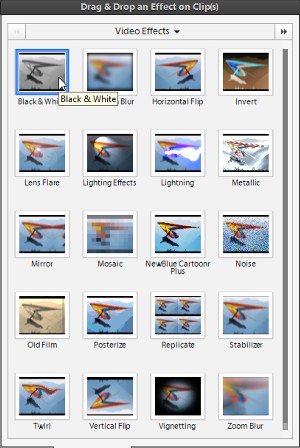 Effects range from blur and sharpen to perspective modification, film looks, and even art effects.
Effects range from blur and sharpen to perspective modification, film looks, and even art effects.
Under each type of effect, you'll find a series of options you can work with.
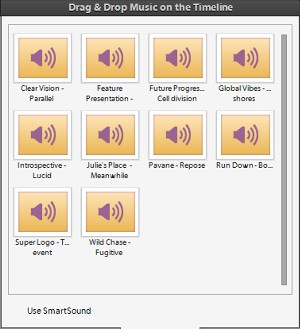 Sounds: Although the sound panel appears anemic with just 10 options, note "Use SmartSound" in the lower left corner. The first time you click, you'll need to download the application, install it, and obtain a free serial number.
Sounds: Although the sound panel appears anemic with just 10 options, note "Use SmartSound" in the lower left corner. The first time you click, you'll need to download the application, install it, and obtain a free serial number.
Once you've done that, you'll see the SmartSound control panel ...
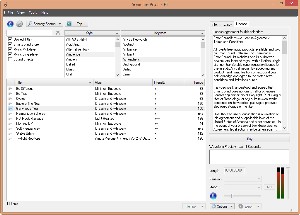 ... and SmartSound offers 53 styles of music and 14 styles of sound effects. Each time you select one, it will be downloaded so you need an Internet connection. Once downloaded, though, you can add it to your video.
... and SmartSound offers 53 styles of music and 14 styles of sound effects. Each time you select one, it will be downloaded so you need an Internet connection. Once downloaded, though, you can add it to your video.
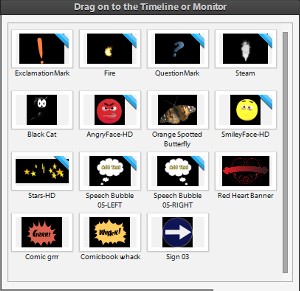 Graphics: Drop one onto your video just for fun. Select from 13 classes (baby, animals, birds, insects, home items, holidays, and such) and then select the enhancement that's just right for your video.
Graphics: Drop one onto your video just for fun. Select from 13 classes (baby, animals, birds, insects, home items, holidays, and such) and then select the enhancement that's just right for your video.
Who Is This Program For?
If you're a professional videographer who specializes in making automotive commercials for General Motors, this is not the right program for you. The high-end professional features that you must have are not present here (nor should you expect them to be). If you need all of those features, then you're looking for Adobe Premiere CS6 and all of the ancillary applications that come with it to handle pre-production, production, and post-production tasks.

 Premiere Elements Hits the Trifecta: Inexpensive, Easy, and Capable.
Premiere Elements Hits the Trifecta: Inexpensive, Easy, and Capable.
Adobe Premiere Elements is designed for people who want to create presentations at home using video from consumer-grade video cameras, point-and-shoot cameras with video functions, digital SLR cameras, and webcams. It's the right choice for people who want a program that's easy to use but who also don't want to be disappointed by finding that they quickly exceed the program's capabilities. Even if you have some experience cutting videos together, you'll have to work hard to find something that any amateur videographer will need to do that Premiere Elements can't do.
For more information, visit the Adobe Premiere Elements website.
What (If Anything) Does Windows 8 Offer Your Business?
Windows 8 is here. You already know that I like it on two notebook computers. Time will tell what I think of it on a desktop system but, starting next week, that's the operating system that will be on my desktop system, the one that doesn't have any touch-screen functionality. But, in all honesty, neither of my notebooks has touch-screen functionality either. So what does this new offering from Microsoft mean if you're a business owner or an IT manager?
Change is always difficult. Windows 8 offers greater flexibility and is clearly better when it comes to device drivers but the new interface is going to confuse some users and require additional training. Some (maybe most) large corporations have only recently upgraded most of their users to Windows 7 (most of them from XP) and Office 2010. Now Microsoft would like them to move to Windows 8 and Office 2013.
As much as I like the way the new operating system and the new office suite work together, that doesn't make it the right choice, a good choice, or even a logical choice for business owners. I'm a geek and it took me maybe an hour to figure out how to use the new operating system and to realize its advantages. Most office workers aren't geeks and will need to be trained.
Windows 8 is the most radical change in the history of Windows. The conversion from Windows 3 to Windows 95 was revolutionary but only in terms of what happened in the background. The user interface was largely unchanged. Windows 8 is revolutionary in terms of the user interface. Legacy applications retain the old desktop workspace but new applications expect to be touched. This makes them more robust on portable devices but many users will be confused.
Some reviewers say that the learning curve for Windows 8 is steep. I've always had a problem with that terminology because "steep" would indicate a quick and easy learning curve but that's not what reviewers mean. They're suggesting that it will take a long time for desktop users to come to grips with Windows 8, which is designed for touch screens. But if users continue to interact with Windows 8 on a notebook or a desktop system, they might be confused by Windows 8 at first. But how long does it take to train people that the desktop is still there for the applications that need it?
If you're a corporate IT person, Windows 8's improved security should be almost a deal clincher regardless of any other issues. Windows 8 makes Web browsing safer. It also improves the security of browser extensions and it makes downloading and using applications safer.
Businesses that are thinking about ignoring Windows 8 may find this to be a bad decision. You could ignore Windows Vista because there was no compelling reason to upgrade. But Windows 8 runs on phones and other mobile devices. Your users will soon start bringing Windows 8 devices onto your networks. So you'd better be ready.
Microsoft’s Surface tablets are going to be popular and you're going to find employees who buy these devices and expect to be able to use them at work.
Windows RT, on the other hand, could simply cause confusion. RT looks like Windows 8 but it won't run "x86" applications. Computers that run Windows RT will look and feel exactly like Windows 8 computers but they won't run applications that people will want them to run. If there's a threat that Microsoft faces, this is it. How many people will buy devices that run Windows RT and then find that they can’t run traditional Windows apps?
RT devices include the Home & Student edition of Microsoft Office 2013. That means that Outlook is absent and using it in an office environment is, to say the least, problematic.
The bottom line for Windows 8 is this: If you're an IT professional who thinks that it won't affect you, your users, or your company, you should probably reconsider that opinion.
Three Spams for the Price of One
Earlier this year, I reported a Microsoft researcher's conjecture that cyber crooks claim to offer great riches from Nigeria because making money depends on quickly and accurately identifying stupid people. Sometimes, though, the ploy doesn't feature Nigeria, and recently I was advised that Google wanted to give me "GBP £950,000.00 {Nine Hundred and Fifty Thousand Great British Pounds Sterling}" because of the company's 15th anniversary. But this is the week that I also received the Cinderella spam and even one that wants to convince me it's from the IRS.
First, Google's Anniversary
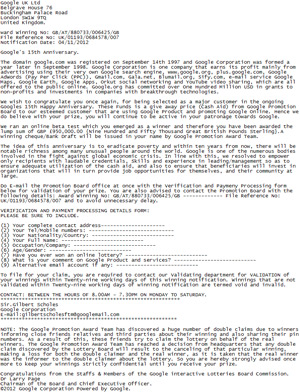 The message purported to be from Google UK Ltd, Belgrave House 76, Buckingham Palace Road, London SW1W 9TQ, United Kingdom.
The message purported to be from Google UK Ltd, Belgrave House 76, Buckingham Palace Road, London SW1W 9TQ, United Kingdom.
And apparently feeling that more numbers makes the fraud more believable I was advised to take note of the following:
ward Winning No: GB/AT/880733/006425/GB (I think they meant "Award" instead of "ward".)
File Reference No: UK/01193/0684578/007
Notification Date: 04/11/2012
Keep in mind that this message is supposed to be FROM Google but Google is mentioned in third person: "The domain google.com was registered on September 14th 1997 and Google Corporation was formed a year later in September 1998. Google Corporation is one company that earns its profit mainly from advertising using their very own Google search engine, www.google.org, plus.google.com, Google AdWords (Pay Per Click (PPC)), Gmail.com, Gala.net, Blumail.org, Sify.com, e-mail service Google Maps, Google Earth, Google Apps, Orkut social networking and YouTube video sharing, which are all offered to the public online. Google.org has committed over One Hundred Million USD in grants to non-profits and investments in companies with breakthrough technologies."
OK, so some of that is true. Google.org is a philanthropic organization but why would Google want to give me any money?
"We wish to congratulate you once again, [Once again? This is the first I've heard of it] for being selected as a major customer in the ongoing Googles [Possessive needs an apostrophe] 15th Happy Anniversary. These Funds is ["These funds is"???] a give away price [Don't you mean "prize"?] (Cash Aid) from Google Promotion Board to our esteemed customer that are ["customer that are" or "customer who is"?] using Google Product and promoting Google Online. Hence we do believe with your prize, you will continue to be active in your patronage towards Google."
But I still don't understand why Google wants to give me nearly 1 million pounds. "We ran an online beta test which you emerged as a winner and therefore you have been awarded the lump sum of GBP £950,000.00 {Nine Hundred and Fifty Thousand Great British Pounds Sterling}.A winning cheque/Bank Draft [Why is "cheque" lower case while "Bank Draft" is capitalized?] will be issued in your name by Google Promotion Award Team."
If you haven't already figured out that this is phony, this paragraph should seal the deal: "The idea of this anniversary is to eradicate poverty and within ten years from now, there will be notable richness among many unusual people around the world. [Do you think that anyone who has even a casual relationship with English wrote that?] Google is one of the numerous bodies involved in the fight against global economic crisis. In line with this, we resolved to empower only recipients with laudable credentials, Skills [what's up with capitalizing "Skills"?] and experience in leading/management ["leading/management"? Do you perhaps mean "leading/managing"?] so as to ensure adequate utilization of the cash aid, and also to ensure that beneficiaries will invest in organizations that will in turn provide job opportunities for themselves, and their community at large."
The message continues in its laughable form: "Do E-mail the Promotion Board office at once with the Verification and Paymeny Processing form ["Paymeny Processing form"?] below for validation of your prize. You are also advised to contact the Promotion Board with the following details: Award Winning No: GB/AT/880733/006425/GB ------------- File Reference No: UK/01193/0684578/007 and to avoid unnecessary delay."
The spam then includes a standard request for identification information.
Continuing to set its bait, the spammer cautions the recipient not to tell anyone (such as a relative with an IQ higher than 30) about the message: "NOTE: The Google Promotion Award Team has discovered a huge number of double claims due to winners informing close friends relatives and third parties about their winning and also sharing their pin numbers. As a result of this, these friends try to claim the lottery on behalf of the real winners. The Google Promotion Award Team has reached a decision from headquarters that any double claim discovered by the Lottery Board will result to the canceling of that particular winning, making a loss for both the double claimer and the real winner, as it is taken that the real winner was the informer to the double claimer about the lottery. So you are hereby strongly advised once more to keep your winnings strictly confidential until you receive your prize."
Now, the Cinderella Spam
I call it that because of the ploy. The message begins with "Hello Dear", which turns out to be an effective indicator of a fraudulent spam. It claims to be from a Cynthia Mossop (or Cynthia Davidson) and it begins this way: "my name is Cynthia Mossop, I am 16 year-old. I am a daughter to Donald and Dawn Mossop who were victims of the Buffalo Plane Crash. My late Dad before his death was the head technician Xerox with branch in US. And had a wife over there which was not disclosed to us (my mom and i). Few months after the death of my parents this woman has come from no where to claim all that my father left for me."
Anyone who reads further is, of course, a fool. But let's see what else the message contains.
I skipped to the bottom of the message and found Cynthia's phone number. In the first paragraph, she said that her father had a wife "over there" in the US so the obvious conclusion is that she is not writing from the United States. Her phone number has a 646 area code. That's New York City, not that I believe for an instant that "she" lives there. Anyone can obtain a number from Skype or some other service that uses a US area code. The calls could be answered in London, Prague, or Abuja (the capital city of Nigeria).
What is it that Cynthia has to offer me? That's where the Cinderella story begins to play out: "As the first daughter, most of my father's properties were willed to me but my step mom in conspiracy with the former Attorney of my dad have tactically and forcefully collected almost everything from me, leaving me with nothing but not known to them is the sum of Six Million Five hundred thousand us dollars ($6.5 Million) with an insurance company in Houston Texas. Several times I have been threatened by my step mom if i knew anything about the money but my consistent answer has been no. My parents before their death use to tell me about the deposit. I barely eat or drink even water in a house that belongs to my parents, because of this case I have dropped out of school. If I continue to live under this roof I am sure I will die, the other day she beat me thoroughly, I am only grateful to God who gave me strength, her lawyer boyfriend has taken over the house and to make it worst they wont allow me out."
Why do scammers always feel that it's important to state the sum in both words and numbers and to note that it is in US dollars. That aside, we now have the hook but what does she want from me? First we have to read through more Cinderella blather: "I am only using the opportunity that she has gone to bed to write you this mail. All i want you do for me is assist me get out of here, i promise that i will not be a liability to you so this is why i want to entrust you with this money. I will tell my dads real attorney that you are a relative of mine from my mom's side please i want you to agree the same if he asks you, So that he would have the mind to release the documents of the deposit to you. He is a very nice man and has been of serious help to me since the death of my parents. All I want is a happy home where i will not have anything to do with them, where i will be free, continue my education and also have a little investment of my own of which you will be in control of."
OK, Cynthia, what is is that you have to offer me? "You can have 40% of the funds. Just save my life please. If you truly want to help me send me your Phone Number, Full name and Home Address so that I can forward to my father's attorney to enable him release the documents of the funds to you so that you can contact the insurance company on my behalf. Although what ever i tell him i know he will do as he is a very good and listening man. I pray for the guidance of the Lord to be with you and your family as you receive this letter. send me text only."
The letter ends with the New York City phone number and a Yahoo.com e-mail address.
If you're mugged while walking down a street, I'll feel sorry for you. But if you respond to messages that are clearly frauds, all I can say is Sorry about your luck.
And Third, a Message from the "IRS"
It's from the IRS if you believe that the IRS sends e-mail from Netherlands.
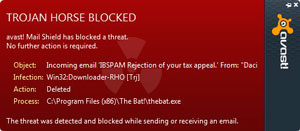 Avast Antivirus didn't believe it. What got Avast's attention, though, wasn't the return address but the infected file that was attached.
Avast Antivirus didn't believe it. What got Avast's attention, though, wasn't the return address but the infected file that was attached.
The file was immediately deleted but the e-mail message was retained.
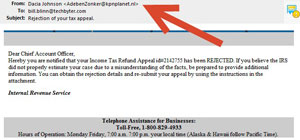 I would have to rate this attempt to impersonate the IRS as extremely poor. Since this message was attempting to place a Trojan horse on my computer, the e-mail shouldn't be attempting to eliminate all but the stupidest people. Those who are distributing this kind of malware want the widest possible dissemination but this message isn't going to get it.
I would have to rate this attempt to impersonate the IRS as extremely poor. Since this message was attempting to place a Trojan horse on my computer, the e-mail shouldn't be attempting to eliminate all but the stupidest people. Those who are distributing this kind of malware want the widest possible dissemination but this message isn't going to get it.
The first clue, of course, is the source of the message—an individual user in Netherlands. Even a dimwit would know that the IRS doesn't send tax notices from outside the United States and most of us know that the IRS doesn't send tax notices via e-mail.
If I want to read the rejection details (click the small image at the right to see a full-size view of the message), all I have to do is open the attachment.
As a police officer I know is fond of saying, "I may have been born at night, but it wasn't last night."
Short Circuits
At Microsoft, Windows Head Heads out the Door
If the choice came down to Steven Sinofsky or Steve Ballmer stepping down, one might reasonably have wished that it would have been Ballmer and not Sinofsky who departed Microsoft. Whether that statement is valid or not won't be answered right away. It may not be answered for year. But the decision by Sinofsky to quit and by Ballmer to accept the resignation will have long-lasting effects.
Sinofsky spent 23 years at Microsoft and just a few weeks ago stood with Ballmer in New York City at the launch party for Windows 8. Neither Microsoft nor Sinofsky has said much about the reasons for the split other than to say that the decision was mutual.
Microsoft's stock prices have been lower than they should be as a result of concern by investors that the company wouldn't be able to bridge the gap between desktop computing (a platform that Microsoft essentially owns) and portable computing (the purview of Apple and Android). Windows 8 is Microsoft's dramatic attempt to perform that daunting task. Wall Street's immediate (not to say "knee-jerk") reaction to Sinofsky's departure was a 3% drop in Microsoft's share prices.
The 47-year-old Sinofsky, who joined Microsoft in 1989 as a software engineer, had been seen as a probable successor for Ballmer, who is 56. Sinofsky had served as an advisor to Bill Gates and later managed the Office suite project before taking over the Windows operation in 2006. Sinofsky's first task was to help Microsoft recover from Windows Vista by rushing the much-improved Windows 7 to market.
Various reports suggest that Sinofsky has repeatedly disagreed with Ballmer and other managers.
Sinofsky sent an e-mail message to Microsoft employees that, in part, said that the decision "was a personal and private choice." He left the Microsoft campus immediately.
Sinofsky wasn't viewed as a team player. At a time when Ballmer is demanding more cooperation across the company's various departments, that trait may well have been the one that did the most damage. Star players are important but so is cohesive leadership. And maybe that reverses—or at least puts into perspective—my opening comment.
Take a Free Online Class and You Might Earn College Credit
If you take one of about 200 classes from more than 30 universities via the Coursera online service, you might earn college credit for the work. The American Council on Education is considering the recommendation but don't get too excited just yet because a pilot project would provide credit for just a handful of classes and each college or university would have to determine whether or not to accept any given class and, if so, how much credit to grant. But it's a start.
The American Council on Education's recommendations are at least given serious consideration by colleges and universities and online education has significant support from the Bill and Melinda Gates Foundation. The Gates Foundation sees benefit in what are called Massive Online Open Courses (MOOC) as a better approach to providing higher education.
One potential problem with MOOCs currently is that no mechanism exists by which the institution that offers the class can guarantee that students are who they claim to be. Coursera will begin offering procedures that will provide ways to verify identifications and to ensure that exams are taken only by students who have signed up for the classes. The classes will continue to be offered for free but those who want to earn college credit will be required to pay what is being termed a modest fee for the credits.
Coursera was founded by two Stanford University professors. The idea has proved popular but most students who sign up for online courses still fail to complete them. This could, in part, be because the students make no financial commitment but also because the work currently doesn't earn credit.
No Program Next Week
Next weekend is the weekend after Thanksgiving and there's usually not a program the weekend after Thanksgiving. In addition, this week is the 40th wedding anniversary of the TechByter and Mrs TechByter. In addition to the addition, this is the week that some of the TechByter Worldwide hardware is being upgraded so between the post-Thanksgiving stupor, the anniversary, tearing the work area apart and putting it back together again, silence seemed to be a good choice. I'll be back the first weekend in December.

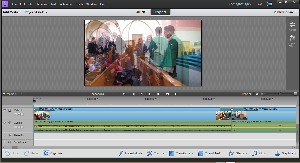


 The author's image: It's that photo over at the right. This explains why TechByter Worldwide was never on television, doesn't it?
The author's image: It's that photo over at the right. This explains why TechByter Worldwide was never on television, doesn't it?
